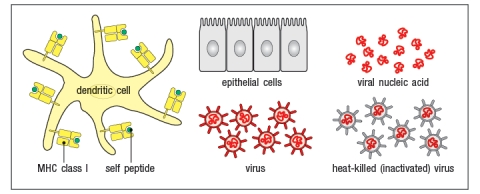Multiple Choice
The virus shown in the diagram below is only able to infect and replicate in epithelial cells. In order for the cross-presenting dendritic cell to display viral peptides, rather than self peptides on its surface MHC class I proteins, which of the following procedures could be utilized, starting with the components shown in Figure? 
A) Mix epithelial cells with heat-killed virus, wait 24 hrs, wash away any virus particles outside the epithelial cells, then add epithelial cells to dendritic cells.
B) Mix epithelial cells with viral peptides, wait 24 hrs, wash away any viral peptides not bound to the epithelial cells, then add epithelial cells to dendritic cells.
C) Mix epithelial cells with live virus particles, wait 24 hrs, wash away any virus particles outside the epithelial cells, then add epithelial cells to dendritic cells.
D) Mix dendritic cells with viral nucleic acids and epithelial cells for 24 hrs.
E) MIx epithelial cells will viral nucleic acids, wait 24 hrs, wash away any viral nucleic acid remaining outside the epithelial cells, then add epithelial cells to dendritic cells.
Correct Answer:

Verified
Correct Answer:
Verified
Q10: MHC class I surface expression is dependent
Q11: A cell line carrying a mutation in
Q12: Some viruses have mechanisms to down-regulate MHC
Q13: Some CD1 molecules bind to glycosphingolipids,
Q14: NKG2D is an activating receptor expressed
Q16: Peptide editing is an important component of
Q17: A family of six (mother, father, and
Q18: The genes encoding MHC proteins are closely
Q19: The mechanism of cross-presentation by dendritic cells
Q20: Three major cell types, dendritic cells, macrophages,